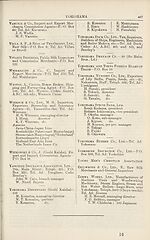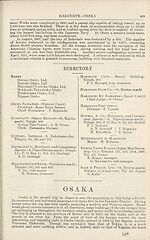1924
(544) [Page 488] - Hakodate
Download files
Complete book:
Individual page:
Thumbnail gallery: Grid view | List view
![(544) [Page 488] - Hakodate](https://deriv.nls.uk/dcn17/1964/3095/196430957.17.jpg)
HAKODATE
This, the most northerly of the old treaty ports of Japan, is situated in the south of
Yezo, in the Straits of Tsugaru, which divide that island from Honshiu. The port lies
in latitude 41 deg. 47 min. 8 sec. N., and longitude 140 deg. 45 min. 34 sec. E., and the
'harbour is nearly land-locked. The town clusters at the foot and on the slope of a bold
rock known to foreigners as Hakodate Head, about 1,000 feet in height, which is within
a fortified area to which the public are not admitted. The surrounding country is
hilly, volcanic, .and striking, but the town itself possesses few attractions. There are
some Public Gardens at the eastern end of the town which contain a small but interest¬
ing Museum. Water works for supplying the town with pure water were completed in
1889. The climate of Hakodate is healthy and bracing. The hottest month is August,
but the thermometer there rarely rises above 90 degrees Fahr.; in the winter it some¬
times sinks to 10 degrees Fahr. or even less, the minimum in an average winter being
about 12 degrees Fahr. The mean temperature throughout the year is about 48
•degrees. The population of Hakodate has been increasing rapidly for many years and
is now about 140,000.
The foreign trade of the port is small, but has been steadily growing during the last
few years, mainly owing to the development of the Kamtschatka salmon fisheries, for
which Hakodate is the principal entrepot. The value of the imports in 1922 was Yen
17,162,417 and the exports Yen 14,867,376. (These figures include the fishing trade
with Asiatic Russia.) The agricultural resources of Yezo have been to some extent
sdeveloped under the auspices of the Kaitakushi, a special Bureau for the development of
the island that ceased to exist many years ago. The rich pasture lands are well adapted
for breeding cattle. In the valuable and extensive fisheries on the coast, however, the
chief exports of the future from Hakodate are to be looked for. Increasing quantities of
dried fish and seaweed are exported annually, mostly to China. The mineral resources of
Yezo are large, and may also some day yield a valuable addition to the exports of
this port. About 3,000,000 tons of coal are annually taken from 41 mines, and the
output of the 18 sulphur mines amounts to about 250,000 tons a year when the
market price makes it profitable to work them. Manganese was produced during
the war boom to the extent of about 10,000 tons a year from five mines
between Hakodate and Otaru, but only a very small proportion of the workings
can be made to pay under normal conditions. Copper has not figured in the export
returns since 1904, though some is mined in the island. Timber has formed the chief
Item in the export list during the past few years. Washing for gold dust has been
carried on in Kitami, and the belief is entertained that with proper machinery the
gold mines of Hokkaido may be worked with fair profit. Silver and magnetic iron
are also obtained. The kerosene wealth of this district is said to be considerable,
but none of the borings has so far given a high yield. At Nukimi-Mura on Soya
Strait—in the extreme north—oil wells were discovered long ago, and have been
worked by hand for some years. The oil, in fact, overflows into the sea, and in stormy
weather boats take refuge at Nukimi-Mura, as the sea is rendered smooth by the oil.
Oil also exists at Nigori-Kawa, near Hakodate; at Kayamagori, near Shiribeshi ; at
Itaibetsu, on a tributary of the Urin River (output 800 gallons per day); at Kotamimura
and Tsukisama Mura (Imperial property), near Sapporo; and near Abashiri, where
the wells are considered rich.
Hakodate is connected with the capital by telegraph, and a line of railway (157
miles) connects Hakodate with Otaru. A railway from Otaru to Sapporo, 22 miles
long, was opened to public traffic on the 28th November, 1880, and has since been carried
on to Poronai, where are some large coal mines, the total length of the line being 56 miles.
A branch to Ikushumbetsu, seven miles, has since been laid, and another line from the
coal mines to Muroran, a port on the south-east of the island, a distance of 143 miles,
was opened to traffic in July, 1892. At the station of Oiwake, from which point there
is a branch line to Yubari (26i miles), the Tanko Tetsudo Kaisha established ovens
for the manufacture of coke. There are now over 1,000 miles of railway in the Hokkaido.
Through communication from Hakodate in the south to the open port of Nemuro in the
north-east was completed in 1921, and another line was carried through to Cape Soya,
the northernmost point of the island, in 1922, and a Government Railway ferry
service has now been inaugurated (May, 1923) between that point and Odomari,
the principal port in Karafuto (Jap. Saghalien). The Hakodate Harbour Improve-
This, the most northerly of the old treaty ports of Japan, is situated in the south of
Yezo, in the Straits of Tsugaru, which divide that island from Honshiu. The port lies
in latitude 41 deg. 47 min. 8 sec. N., and longitude 140 deg. 45 min. 34 sec. E., and the
'harbour is nearly land-locked. The town clusters at the foot and on the slope of a bold
rock known to foreigners as Hakodate Head, about 1,000 feet in height, which is within
a fortified area to which the public are not admitted. The surrounding country is
hilly, volcanic, .and striking, but the town itself possesses few attractions. There are
some Public Gardens at the eastern end of the town which contain a small but interest¬
ing Museum. Water works for supplying the town with pure water were completed in
1889. The climate of Hakodate is healthy and bracing. The hottest month is August,
but the thermometer there rarely rises above 90 degrees Fahr.; in the winter it some¬
times sinks to 10 degrees Fahr. or even less, the minimum in an average winter being
about 12 degrees Fahr. The mean temperature throughout the year is about 48
•degrees. The population of Hakodate has been increasing rapidly for many years and
is now about 140,000.
The foreign trade of the port is small, but has been steadily growing during the last
few years, mainly owing to the development of the Kamtschatka salmon fisheries, for
which Hakodate is the principal entrepot. The value of the imports in 1922 was Yen
17,162,417 and the exports Yen 14,867,376. (These figures include the fishing trade
with Asiatic Russia.) The agricultural resources of Yezo have been to some extent
sdeveloped under the auspices of the Kaitakushi, a special Bureau for the development of
the island that ceased to exist many years ago. The rich pasture lands are well adapted
for breeding cattle. In the valuable and extensive fisheries on the coast, however, the
chief exports of the future from Hakodate are to be looked for. Increasing quantities of
dried fish and seaweed are exported annually, mostly to China. The mineral resources of
Yezo are large, and may also some day yield a valuable addition to the exports of
this port. About 3,000,000 tons of coal are annually taken from 41 mines, and the
output of the 18 sulphur mines amounts to about 250,000 tons a year when the
market price makes it profitable to work them. Manganese was produced during
the war boom to the extent of about 10,000 tons a year from five mines
between Hakodate and Otaru, but only a very small proportion of the workings
can be made to pay under normal conditions. Copper has not figured in the export
returns since 1904, though some is mined in the island. Timber has formed the chief
Item in the export list during the past few years. Washing for gold dust has been
carried on in Kitami, and the belief is entertained that with proper machinery the
gold mines of Hokkaido may be worked with fair profit. Silver and magnetic iron
are also obtained. The kerosene wealth of this district is said to be considerable,
but none of the borings has so far given a high yield. At Nukimi-Mura on Soya
Strait—in the extreme north—oil wells were discovered long ago, and have been
worked by hand for some years. The oil, in fact, overflows into the sea, and in stormy
weather boats take refuge at Nukimi-Mura, as the sea is rendered smooth by the oil.
Oil also exists at Nigori-Kawa, near Hakodate; at Kayamagori, near Shiribeshi ; at
Itaibetsu, on a tributary of the Urin River (output 800 gallons per day); at Kotamimura
and Tsukisama Mura (Imperial property), near Sapporo; and near Abashiri, where
the wells are considered rich.
Hakodate is connected with the capital by telegraph, and a line of railway (157
miles) connects Hakodate with Otaru. A railway from Otaru to Sapporo, 22 miles
long, was opened to public traffic on the 28th November, 1880, and has since been carried
on to Poronai, where are some large coal mines, the total length of the line being 56 miles.
A branch to Ikushumbetsu, seven miles, has since been laid, and another line from the
coal mines to Muroran, a port on the south-east of the island, a distance of 143 miles,
was opened to traffic in July, 1892. At the station of Oiwake, from which point there
is a branch line to Yubari (26i miles), the Tanko Tetsudo Kaisha established ovens
for the manufacture of coke. There are now over 1,000 miles of railway in the Hokkaido.
Through communication from Hakodate in the south to the open port of Nemuro in the
north-east was completed in 1921, and another line was carried through to Cape Soya,
the northernmost point of the island, in 1922, and a Government Railway ferry
service has now been inaugurated (May, 1923) between that point and Odomari,
the principal port in Karafuto (Jap. Saghalien). The Hakodate Harbour Improve-
Set display mode to:
![]() Universal Viewer |
Universal Viewer | ![]() Mirador |
Large image | Transcription
Mirador |
Large image | Transcription
Images and transcriptions on this page, including medium image downloads, may be used under the Creative Commons Attribution 4.0 International Licence unless otherwise stated. ![]()
| Asian directories and chronicles > 1924 > (544) [Page 488] - Hakodate |
|---|
| Permanent URL | https://digital.nls.uk/196430955 |
|---|
| Attribution and copyright: |
|
|---|---|
| Description | Volumes from the Asian 'Directory and Chronicle' series covering 1917-1941, but missing 1919 and 1923. Compiled annually from a multiplicity of local sources and research. They provide listings of each country's active corporations, foreign residents and government agencies of all nationalities for that year, together with their addresses. Content includes: various treaties; coverage of conflicts; currencies and taxes; consular fees; weights and measures; public holidays; festivals and traditions. A source of information for both Western states and communities of foreigners living in Asia. Published by Hongkong Daily Press. |
|---|---|
| Shelfmark | H3.86.1303 |
| Additional NLS resources: |

